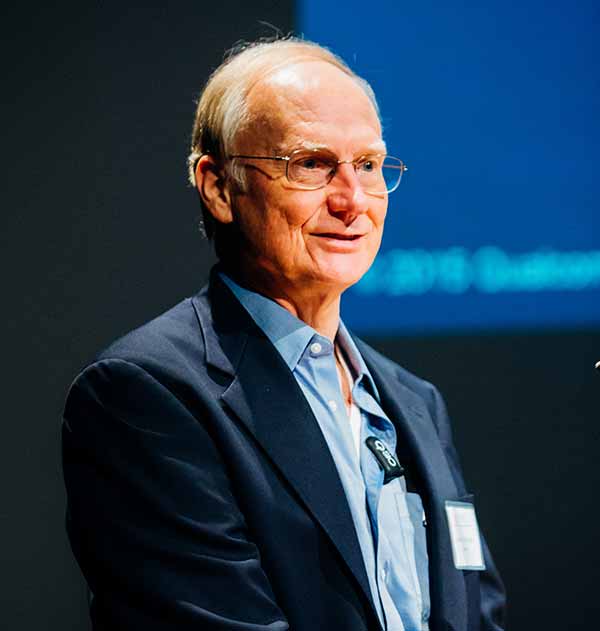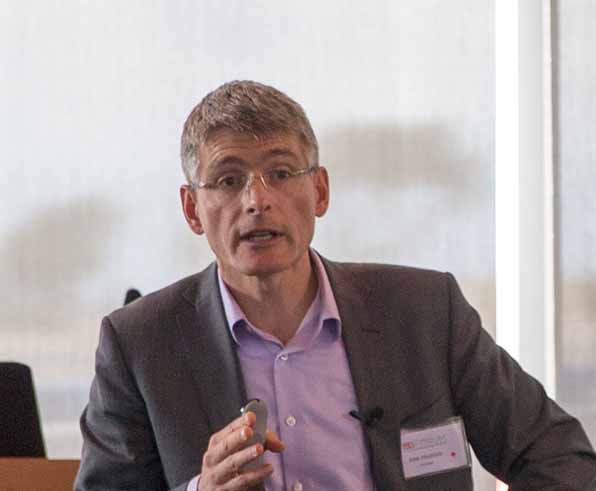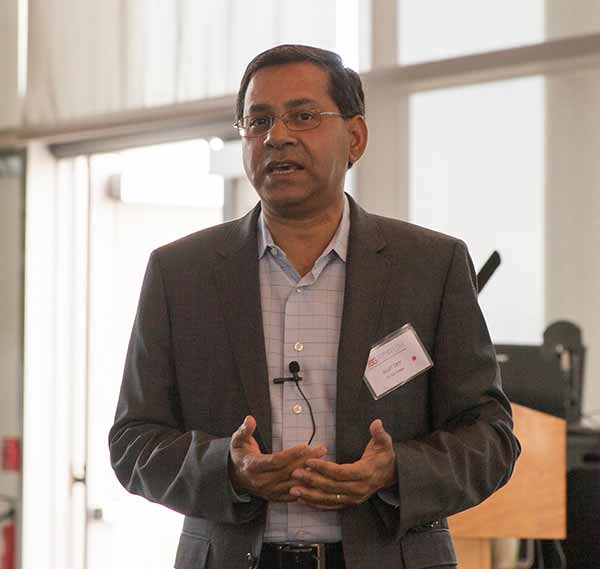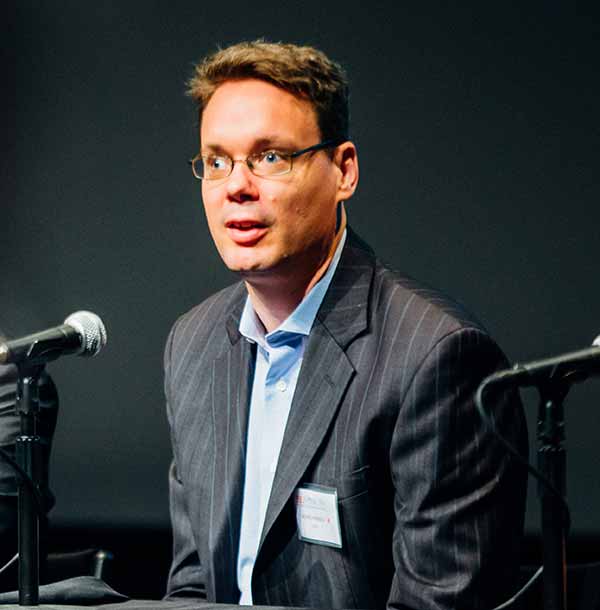
5G Wireless Forum: The Promise and the Peril of Future Wireless Systems
Published Date
By:
- Tiffany Fox
Share This:
Article Content
The format for the recent 5G Forum on Next-Generation Wireless Systems and Applications, held at the University of California, San Diego, was a reflection of the two poles — the promise and the peril — that define the future of wireless technology.
If all goes according to plan, the next decade of advances in mobile technology promises to transform a vast array of sectors, from government to transportation to public health. It will be possible, for example, to use an array of devices to wirelessly monitor your body for any sign of illness, hold a preliminary e-consultation with your physician should a question arise and then also predict whether or not traffic flow will make you late to your follow-up doctor’s appointment.

Ed Tiedemann, Senior Vice President of Engineering at Qualcomm
For this to happen, engineers must provide the technological infrastructure required for 5G: chiefly, on-demand connectivity both indoors and outdoors, with time delays of less than a second, all in a device that’s cheaper, lighter, more secure and more energy-efficient.
Some of the biggest players in wireless engineering — including more than 100 representatives from UC San Diego, Qualcomm, Yahoo!, Intel, Ericsson, Samsung, Mitsubishi Electric, Nokia, Keysight Technologies, Symantec Research Labs, Kaiser Permanente and the City of San Diego — attended the two-day forum. The event was hosted on May 14-15 by the UC San Diego Center for Wireless Communications and featured panel discussions, presentations and demonstrations showcasing both best practices and remaining research questions pertaining to wireless systems and applications.
The key takeaway from the forum: For each exciting enhancement promised by 5G, there is an equally daunting challenge. The titles of the sessions alone were reflective of this dichotomy — “Smart Cities, Wearables and Government: What Drives Technology Requirements in Internet of Things” and “mHealth Revolution: How 5G Can Impact Future Health Care Delivery” were followed by “5G Radio Architectures: Innovations and Challenges” and “Addressing Power Challenges in 5G.”
If many of those topics sound familiar, it’s because they are. As keynote speaker Ed Tiedemann, Senior Vice President of Engineering at Qualcomm noted, telecommunications have “always been about enabling new services, empowering new user experiences and connecting new industries and devices.”
Mobile technology, noted Tiedemann, “has made a leap every 10 years,” from first-generation analog voice in the 1980s, to 2G digital voice in the early 1990s, 3G in the first part of the century and 4G or LTE (Long-Term Evolution) in the last decade.

Ericsson Chief Technology Officer Erik Ekudden
But as keynote speaker and Ericsson Chief Technology Officer Erik Ekudden pointed out, “5G technology will go way beyond the smartphones, TVs, tablets and other devices that we're using today.” Although advances in wireless technology will soon make it possible to download gigabytes of data in a second from our phones (allowing us to watch 3D video or work and play in the cloud from our devices), 5G will also lead to improvements in augmented reality, industry automation, wearable devices, mission critical apps (such as ehealth applications) and self-driving cars.
The so-called Internet of Things (IoT) — which wirelessly connects common objects like home-lighting systems and appliances — is shaping up to be another major focus for 5G developers. Another key enhancement over LTE, noted Tiedemann, will be device-to-device communication, which bypasses the need for a cellular tower.
“One of the key things in 5G is getting much more connectivity, especially connectivity in bad spots,” he said, adding that device-to-device communication also enhances energy efficiency. “The energy being used for the Chinese cellular and communications system is almost (equivalent to) the entire energy system of Taiwan. As we get smaller and smaller cells, maybe there’s a cell in this room that’s used only a few hours per day. We need to start looking for ways that we keep from expending energy when it’s not being used.”

UC San Diego Center for Wireless Communications Director Sujit Dey
UC San Diego’s Sujit Dey is doing just that. Dey, who is director of the CWC, is leading an effort to save power consumed by the base stations by switching off the antennas from time to time and sometimes leaving them idle. This strategy can also be applied to batteries, said Dey: Systems can draw power from them in various bursts (rather than continuously draining them), and leave them idle periodically to give them time to rest.
“A challenge with using renewable energy like solar and wind is its intermittent nature (power generation is not consistent throughout the day)," explained Dey. "By matching the energy consumption of the base station with the solar/wind energy generation, we can reduce grid power usage.”
The financial challenges involved in driving these core technologies are also substantial, said Mark Pierpoint, Vice President and General Manager of Keysight Technologies and a keynote speaker at the forum.
Take massive MIMO. Multi-input, multi-output (MIMO) technology is a wireless broadband standard that equips cellular base stations with more than one antenna to maximize the possible number of signal paths and thus enhance performance in terms of data rate and reliability. The tradeoff is increased complexity and energy consumption. Massive MIMO addresses this problem by equipping the base station with a massive number of antennas that can adapt to focus transmission or reception of a signal. Yet even the promise of massive MIMO is compromised by the move to millimeter wave (MMW) frequencies, extremely high radio frequencies (30 to 300 gHz) in the electromagnetic spectrum.
“A key challenge of massive MIMO is that it’s an exercise in scaling the most expensive part of the scaling procedure: the RF (radio frequency) portions,” explained Pierpoint. “As soon as you move above a few gigahertz (on the wireless spectrum), power becomes extremely expensive. That’s going to be one of the key things with 5G, especially with higher millimeter wave frequency, all of which I can tell you we’re not well set up to deal with. We believe going forward you’re going to need some key performance indicators, so these are definitely research topics.”
Optimizing data rate and reliability is crucial for many of the technologies that are emerging from the tail-end of LTE and the early stages of 5G. During a panel discussion moderated by Dimitri Arges of SomaSens Insight, Yan Chow, Chief Information Officer for LongView International Technology Solutions, noted that technologies like robotic surgeries, streaming data while monitoring patients in real-time and e-consults between doctors and patients will require a latency of less than one second.
A second panel speaker on the “mHealth Revolution” was Jun Huang, Senior Director of Enterprise Architecture for Kaiser Permanente Information Technology. Huang emphasized that health care must be put into the hands of patients and consumers using technology to “treat them wherever they are.” The Kaiser Permanente mobile app, he noted, allows patients to interact directly with their physicians by, for example, texting photographs of a skin disorder to determine if requires a visit to the clinic. Physicians can also use the app to order lab results, do remote consultations with patients, manage their patient schedules and collaborate with other doctors. Huang acknowledged that the technology has its downsides – primarily a lack of bandwidth and reliability – but said that he sees those problems being addressed by 5G technologies.
Huang’s fellow panelist, Senior Director of Marketing for Edico Genome, Gavin Stone, noted another of the quandaries that 5G developers must factor in: The avalanche of big data. Stone said that his company’s ultimate goal is to harness the power of 5G networks to process genomic data more quickly to provide prompt diagnosis and treatment for patients. But that’s easier said than done – by some estimates, an analysis of a single person’s genome could comprise 200 gigabytes of data.

Boris Karsch, Vice President of Strategy and Business Development for Cubic Transportation Systems
Then come the security challenges associated with gathering, storing and mining this avalanche of data, particularly data in IoT-connected devices, noted Boris Karsch, Vice President of Strategy and Business Development for Cubic Transportation Systems.
“From a systems engineering point of view, we need to follow best practices to be sure that data is kept securely,” said Karsch. ”The issue is when data come out of these silent systems and get combined with other data, how do we depersonalize the data in a way that it can’t be personalized? How do we build in more security and more privacy by design?”
Petros Efstathopoulos, Technical Director of Symantec Research Labs and Karsch’s fellow panelist, suggested that a focus on protecting data itself might be too little, too late.
“Most people focus on (protecting) data, but there’s no point doing that unless we have made sure that the infrastructure is secure,” he explained. “If you can’t trust data, why protect it? It’s very important to establish mechanisms for identity, so if I can’t trust who you say you are it’s a house of cards and the pyramid collapses. These are fundamental things that can be built into the protocol.”
The point on which everyone seemed to agree is one expressed by Jong-Kae Fwu, Director of Next-Generation Technologies and Standards for Intel: “We are at a technology turning point, and 5G is expected to share the global wireless industry for the next decade.
“We are evolving from always-on to always-connected to always-networking,” Fwu added. “The future generation of wireless needs a broader cooperation between industry and universities. Computing and communication need to come together to deliver this user experience.”
Share This:
You May Also Like
Stay in the Know
Keep up with all the latest from UC San Diego. Subscribe to the newsletter today.


